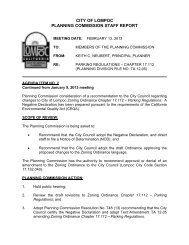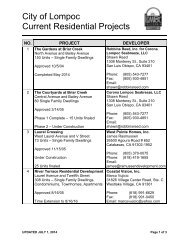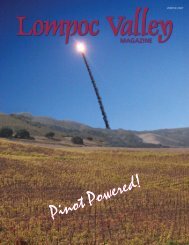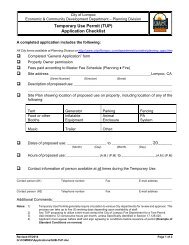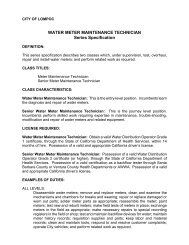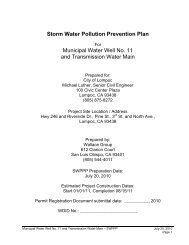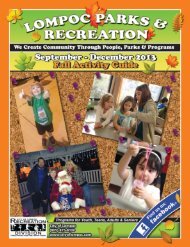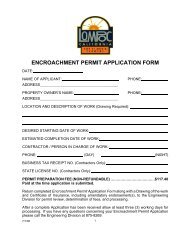Noise and Air Quality - the City of Lompoc!
Noise and Air Quality - the City of Lompoc!
Noise and Air Quality - the City of Lompoc!
- No tags were found...
Create successful ePaper yourself
Turn your PDF publications into a flip-book with our unique Google optimized e-Paper software.
<strong>City</strong> <strong>of</strong> <strong>Lompoc</strong> General Plan UpdateIssue Paper on <strong>Noise</strong> <strong>and</strong> <strong>Air</strong> <strong>Quality</strong> IssuesSETTING<strong>Noise</strong>Background. <strong>Noise</strong> has been defined as unwanted sound <strong>and</strong> is known to have severaladverse effects on people. From <strong>the</strong>se known effects <strong>of</strong> noise, criteria have been established tohelp protect <strong>the</strong> public health <strong>and</strong> safety <strong>and</strong> prevent disruption <strong>of</strong> certain human activities.These criteria are based on known impacts <strong>of</strong> noise on people such as hearing loss, speechinterference, sleep interference, physiological responses <strong>and</strong> annoyance.Sound is technically described in terms <strong>of</strong> <strong>the</strong> loudness (amplitude) <strong>of</strong> <strong>the</strong> sound <strong>and</strong> frequency(pitch) <strong>of</strong> <strong>the</strong> sound. The st<strong>and</strong>ard unit <strong>of</strong> measurement <strong>of</strong> <strong>the</strong> loudness <strong>of</strong> sound is <strong>the</strong> Decibel(dB). Since <strong>the</strong> human ear is not equally sensitive to sound at all frequencies, <strong>the</strong> A-weighteddecibel scale (dBA) relates noise to human sensitivity by discriminating against frequencies in amanner similar to <strong>the</strong> human ear.Decibels are based on <strong>the</strong> logarithmic scale, which compresses <strong>the</strong> wide range in soundpressure levels to a more usable range <strong>of</strong> numbers just as <strong>the</strong> Richter scale measuresearthquakes. In terms <strong>of</strong> human response to noise, a sound 10 dBA higher than ano<strong>the</strong>r isjudged to be twice as loud; a sound 20 dBA higher four times as loud, <strong>and</strong> so forth. Everydaysounds normally range from 30 dB (very quiet) to 100 dB (very loud). In general, a 3 dB changein community noise levels is noticeable, while 1-2 dB changes are generally not perceived.In addition to <strong>the</strong> actual instantaneous measurement <strong>of</strong> sound levels, <strong>the</strong> duration <strong>of</strong> sound isimportant since sounds that occur over a long period <strong>of</strong> time are more likely to be an annoyanceor cause direct physical damage or environmental stress. Several rating scales have beendeveloped to account for <strong>the</strong> known effects <strong>of</strong> noise on people. Based on <strong>the</strong>se effects, <strong>the</strong>observation has been made that <strong>the</strong> potential for noise to impact people is dependent on <strong>the</strong>total acoustical energy content <strong>of</strong> <strong>the</strong> noise. A number <strong>of</strong> noise scales have been developed toaccount for this factor, including <strong>the</strong> Equivalent <strong>Noise</strong> Level (Leq), <strong>the</strong> Day Night <strong>Noise</strong> Level(LDN) <strong>and</strong> <strong>the</strong> Community <strong>Noise</strong> Equivalent Level (CNEL).Intermittent or occasional noise such as that associated with stationary noise sources is not <strong>of</strong>sufficient volume to exceed community noise st<strong>and</strong>ards that are based on a time averagedscale such as <strong>the</strong> LDN scale. To account for intermittent noise, <strong>the</strong> Percent <strong>Noise</strong> Level (L%)scale is used. The Percent <strong>Noise</strong> Level is <strong>the</strong> level exceeded a percentage <strong>of</strong> <strong>the</strong> time during<strong>the</strong> measurement period. <strong>Noise</strong> Ordinances are typically specified in terms <strong>of</strong> <strong>the</strong> percent noiselevels. Ordinances are designed to protect people from noise sources such as music,machinery <strong>and</strong> vehicular traffic on private property.Local Issues. Existing noise sources in <strong>the</strong> region include roadway noise, agriculturalproduction, <strong>the</strong> Union Pacific Railroad, <strong>Lompoc</strong> <strong>Air</strong>port, <strong>and</strong> mining operations. <strong>Noise</strong> issuesare currently primarily from vehicle noise from roadways. <strong>Noise</strong> generated by roadways isdependant on <strong>the</strong> speed <strong>and</strong> volume <strong>of</strong> vehicles that use <strong>the</strong> roadways.1<strong>City</strong> <strong>of</strong> <strong>Lompoc</strong>



